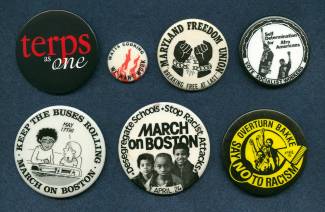Collection Name
About
In early September 2007 a noose was found hanging from a tree on the University of Maryland campus. The tree was located near a building used to house numerous black organizations, and the noose was clearly seen as an emotional reminder of the horrific crime and terror of lynching against blacks. This "Terps as One" button was distributed at a rally held on campus on September 11, 2007 to protest the racism and intolerance evoked by the noose.
The 1965 Watts Riot of Los Angeles was the first of the urban riots that characterized much of the nation in the latter part of the 1960s. The riot started on August 11, 1965 after a confrontation between a police officer and onlookers during a vehicle stop resulted in claims of police brutality spreading through the neighborhood. The Watts Riot, which included the looting and burning of white-owned businesses lasted five days, and resulted in 34 deaths. Over 30,000 blacks took part in the riot, and over 35,000 police officers and National Guardsmen were required to restore order.
Although the Watts Riot was seen by many as simply a mob action with criminal intent, there was also an underlying anger, simmering in the heat of summer, pertaining to the mostly all-white police force and, as alluded to in the button, a growing frustration over the lack of jobs and economic independence.
In 1974 a United States District Court Judge found the City of Boston guilty of intentional segregation of its schools. This was held to be unconstitutional. The result was court ordered busing - busing black and white students across the city to integrate the school system. Numerous demonstrations, marches, and boycotts were undertaken, primarily by the white neighborhoods of South Boston. School buses carrying black children were confronted by white crowds threatening violence and yelling racial slurs, and several violent incidents, initiated by both sides, occurred. It would be several years before things would calm down. The 1975 "Keep the Buses Rolling" button depicted here is by Doonesbury cartoonist, Garry Trudeau.
The Maryland Freedom Workers Union was formed in 1966. Assisted by the Congress of Racial Equality (CORE), its initial purpose was to help organize nurse's aids, housekeepers, and kitchen staff at a Baltimore nursing home. It spread to other venues, such as small retail establishments, resulting in the formation of Maryland Freedom Local #1.
It was at the 1968 Summer Olympics in Mexico City. Tommie Smith and John Carlos, teammates at San Jose State University in California, had just won the Gold and Bronze medals respectively. As they received their medals, and the American flag was raised and the National Anthem played, both men bowed their heads and raised their fists in a Black Power salute. They noted afterwards this was meant to be a non-violent protest in the tradition of Martin Luther King, Jr. emphasizing the need for black unity and power. Both men had worn black socks, but no shoes, on the platform to characterize black poverty and economic depression. They were then suspended from the American team. In 2005 a bronze statue honoring Smith and Carlos and portraying them on the medal platform was dedicated on the San Jose campus.
Allen Bakke was a white student who in 1974 was denied admittance to the University of California medical school. The school had a separate admissions policy for minority applicants, reserved a set number of spots for minority students, and accepted some with less qualifications then Bakke. He sued, and won in the California Courts. Finally, in 1978 the U.S. Supreme Court ruled that quota systems based on race, such as those used against Bakke, were discriminatory and unconstitutional. At the same time, the Court upheld the constitutionality of affirmative action programs. The legal debate continues to this day. The Bakke button depicted here is from April 15, 1978 when more than 20,000 people turned out in Washington D.C. to protest the Bakke decision.
Buttons from the collection of Albert and Angela Feldstein
Text from over forty years of notes, newspaper and magazine clippings, flyers, and other sources associated with the collecting of buttons and used in the research of the 2003 political history poster entitled, "Buttons of the Cause, 1960-2003: The Events, The People, The Organizations, The Issues".
